Zhiyuan Hu
Image Aesthetic Reasoning via HCM-GRPO: Empowering Compact Model for Superior Performance
Nov 13, 2025Abstract:The performance of image generation has been significantly improved in recent years. However, the study of image screening is rare and its performance with Multimodal Large Language Models (MLLMs) is unsatisfactory due to the lack of data and the weak image aesthetic reasoning ability in MLLMs. In this work, we propose a complete solution to address these problems in terms of data and methodology. For data, we collect a comprehensive image screening dataset with over 128k samples, about 640k images. Each sample consists of an original image, four generated images. The dataset evaluates the image aesthetic reasoning ability under four aspects: appearance deformation, physical shadow, placement layout, and extension rationality. Regarding data annotation, we investigate multiple approaches, including purely manual, fully automated, and answer-driven annotations, to acquire high-quality chains of thought (CoT) data in the most cost-effective manner. Methodologically, we introduce a Hard Cases Mining (HCM) strategy with a Dynamic Proportional Accuracy (DPA) reward into the Group Relative Policy Optimization (GRPO) framework, called HCM-GRPO. This enhanced method demonstrates superior image aesthetic reasoning capabilities compared to the original GRPO. Our experimental results reveal that even state-of-the-art closed-source MLLMs, such as GPT4o and Qwen-VL-Max, exhibit performance akin to random guessing in image aesthetic reasoning. In contrast, by leveraging the HCM-GRPO, we are able to surpass the scores of both large-scale open-source and leading closed-source models with a much smaller model.
Undersampled Phase Retrieval with Image Priors
Sep 18, 2025Abstract:Phase retrieval seeks to recover a complex signal from amplitude-only measurements, a challenging nonlinear inverse problem. Current theory and algorithms often ignore signal priors. By contrast, we evaluate here a variety of image priors in the context of severe undersampling with structured random Fourier measurements. Our results show that those priors significantly improve reconstruction, allowing accurate reconstruction even below the weak recovery threshold.
Not All Tokens and Heads Are Equally Important: Dual-Level Attention Intervention for Hallucination Mitigation
Jun 14, 2025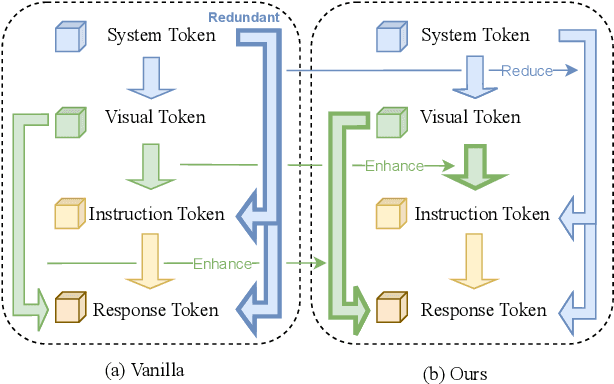

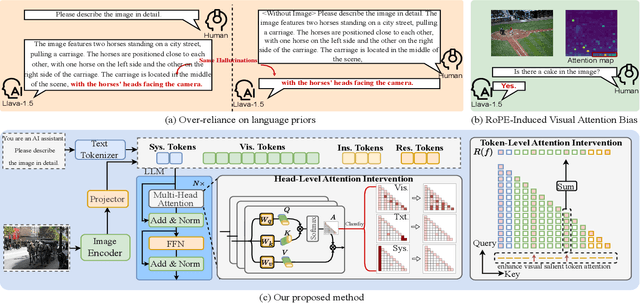

Abstract:Large vision-language models (LVLMs) have shown remarkable capabilities across a wide range of multimodal tasks. However, they remain prone to visual hallucination (VH), often producing confident but incorrect descriptions of visual content. We present VisFlow, an efficient and training-free framework designed to mitigate VH by directly manipulating attention patterns during inference. Through systematic analysis, we identify three key pathological attention behaviors in LVLMs: (1) weak visual grounding, where attention to visual tokens is insufficient or misallocated, over-focusing on uninformative regions; (2) language prior dominance, where excessive attention to prior response tokens reinforces autoregressive patterns and impairs multimodal alignment; (3) prompt redundancy, where many attention heads fixate on system prompt tokens, disrupting the integration of image, instruction, and response content. To address these issues, we introduce two inference-time interventions: token-level attention intervention (TAI), which enhances focus on salient visual content, and head-level attention intervention (HAI), which suppresses over-attention to prompt and nearby text tokens. VisFlow operates without additional training or model modifications. Extensive experiments across models and benchmarks show that VisFlow effectively reduces hallucinations and improves visual factuality, with negligible computational cost.
BehaviorSFT: Behavioral Token Conditioning for Clinical Agents Across the Proactivity Spectrum
May 27, 2025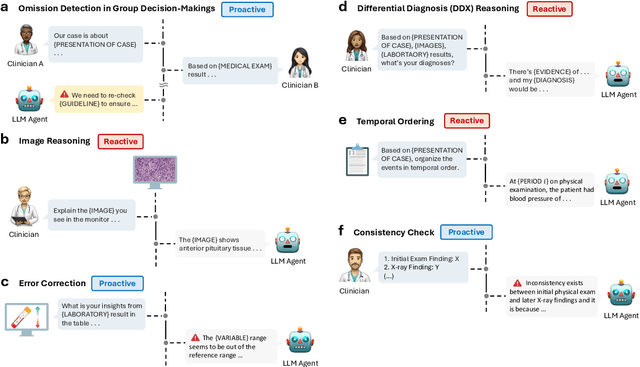

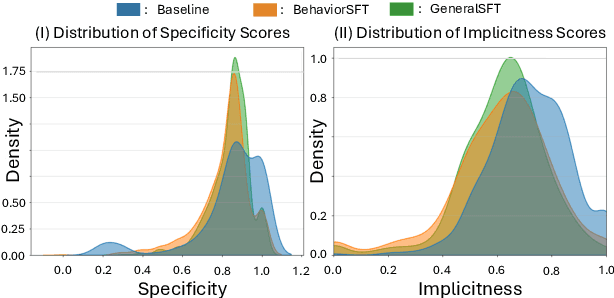
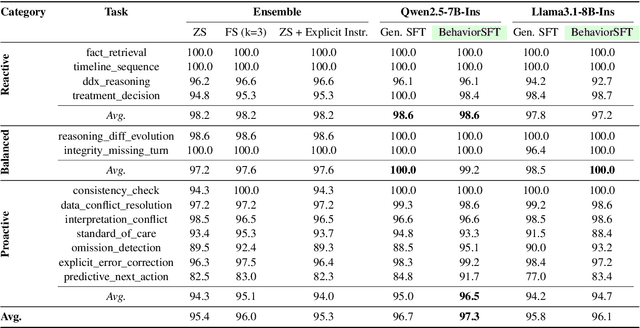
Abstract:Large Language Models (LLMs) as clinical agents require careful behavioral adaptation. While adept at reactive tasks (e.g., diagnosis reasoning), LLMs often struggle with proactive engagement, like unprompted identification of critical missing information or risks. We introduce BehaviorBench, a comprehensive dataset to evaluate agent behaviors across a clinical assistance spectrum, ranging from reactive query responses to proactive interventions (e.g., clarifying ambiguities, flagging overlooked critical data). Our BehaviorBench experiments reveal LLMs' inconsistent proactivity. To address this, we propose BehaviorSFT, a novel training strategy using behavioral tokens to explicitly condition LLMs for dynamic behavioral selection along this spectrum. BehaviorSFT boosts performance, achieving up to 97.3% overall Macro F1 on BehaviorBench and improving proactive task scores (e.g., from 95.0% to 96.5% for Qwen2.5-7B-Ins). Crucially, blind clinician evaluations confirmed BehaviorSFT-trained agents exhibit more realistic clinical behavior, striking a superior balance between helpful proactivity (e.g., timely, relevant suggestions) and necessary restraint (e.g., avoiding over-intervention) versus standard fine-tuning or explicit instructed agents.
DeepInverse: A Python package for solving imaging inverse problems with deep learning
May 26, 2025Abstract:DeepInverse is an open-source PyTorch-based library for solving imaging inverse problems. The library covers all crucial steps in image reconstruction from the efficient implementation of forward operators (e.g., optics, MRI, tomography), to the definition and resolution of variational problems and the design and training of advanced neural network architectures. In this paper, we describe the main functionality of the library and discuss the main design choices.
Temporal-Oriented Recipe for Transferring Large Vision-Language Model to Video Understanding
May 19, 2025Abstract:Recent years have witnessed outstanding advances of large vision-language models (LVLMs). In order to tackle video understanding, most of them depend upon their implicit temporal understanding capacity. As such, they have not deciphered important components that contribute to temporal understanding ability, which might limit the potential of these LVLMs for video understanding. In this work, we conduct a thorough empirical study to demystify crucial components that influence the temporal understanding of LVLMs. Our empirical study reveals that significant impacts are centered around the intermediate interface between the visual encoder and the large language model. Building on these insights, we propose a temporal-oriented recipe that encompasses temporal-oriented training schemes and an upscaled interface. Our final model developed using our recipe significantly enhances previous LVLMs on standard video understanding tasks.
Beyond 'Aha!': Toward Systematic Meta-Abilities Alignment in Large Reasoning Models
May 15, 2025Abstract:Large reasoning models (LRMs) already possess a latent capacity for long chain-of-thought reasoning. Prior work has shown that outcome-based reinforcement learning (RL) can incidentally elicit advanced reasoning behaviors such as self-correction, backtracking, and verification phenomena often referred to as the model's "aha moment". However, the timing and consistency of these emergent behaviors remain unpredictable and uncontrollable, limiting the scalability and reliability of LRMs' reasoning capabilities. To address these limitations, we move beyond reliance on prompts and coincidental "aha moments". Instead, we explicitly align models with three meta-abilities: deduction, induction, and abduction, using automatically generated, self-verifiable tasks. Our three stage-pipeline individual alignment, parameter-space merging, and domain-specific reinforcement learning, boosting performance by over 10\% relative to instruction-tuned baselines. Furthermore, domain-specific RL from the aligned checkpoint yields an additional 2\% average gain in the performance ceiling across math, coding, and science benchmarks, demonstrating that explicit meta-ability alignment offers a scalable and dependable foundation for reasoning. Code is available at: https://github.com/zhiyuanhubj/Meta-Ability-Alignment
Guiding VLM Agents with Process Rewards at Inference Time for GUI Navigation
Apr 22, 2025Abstract:Recent advancements in visual language models (VLMs) have notably enhanced their capabilities in handling complex Graphical User Interface (GUI) interaction tasks. Despite these improvements, current frameworks often struggle to generate correct actions in challenging GUI environments. State-of-the-art commercial VLMs are black-boxes, and fine-tuning open-source VLMs for GUI tasks requires significant resources. Additionally, existing trajectory-level evaluation and refinement techniques frequently fall short due to delayed feedback and local optimization issues. To address these challenges, we propose an approach that guides VLM agents with process supervision by a reward model during GUI navigation and control at inference time. This guidance allows the VLM agent to optimize actions at each inference step, thereby improving performance in both static and dynamic environments. In particular, our method demonstrates significant performance gains in three GUI navigation tasks, achieving a 3.4% improvement in single step action accuracy for static environments, along with a around 33% increase in task success rate in one dynamic environment. With further integration of trajectory reflection and retry mechanisms, we also demonstrate even greater enhancement in task success.
Ride-Sourcing Vehicle Rebalancing with Service Accessibility Guarantees via Constrained Mean-Field Reinforcement Learning
Mar 31, 2025Abstract:The rapid expansion of ride-sourcing services such as Uber, Lyft, and Didi Chuxing has fundamentally reshaped urban transportation by offering flexible, on-demand mobility via mobile applications. Despite their convenience, these platforms confront significant operational challenges, particularly vehicle rebalancing - the strategic repositioning of thousands of vehicles to address spatiotemporal mismatches in supply and demand. Inadequate rebalancing results in prolonged rider waiting times, inefficient vehicle utilization, and inequitable distribution of services, leading to disparities in driver availability and income. To tackle these complexities, we introduce scalable continuous-state mean-field control (MFC) and reinforcement learning (MFRL) models that explicitly represent each vehicle's precise location and employ continuous repositioning actions guided by the distribution of other vehicles. To ensure equitable service distribution, an accessibility constraint is integrated within our optimal control formulation, balancing operational efficiency with equitable access to the service across geographic regions. Our approach acknowledges realistic conditions, including inherent stochasticity in transitions, the simultaneous occurrence of vehicle-rider matching, vehicles' rebalancing and cruising, and variability in rider behaviors. Crucially, we relax the traditional mean-field assumption of equal supply-demand volume, better reflecting practical scenarios. Extensive empirical evaluation using real-world data-driven simulation of Shenzhen demonstrates the real-time efficiency and robustness of our approach at the scale of tens of thousands of vehicles. The code is available at https://github.com/mjusup1501/mf-vehicle-rebalancing.
JudgeLRM: Large Reasoning Models as a Judge
Mar 31, 2025
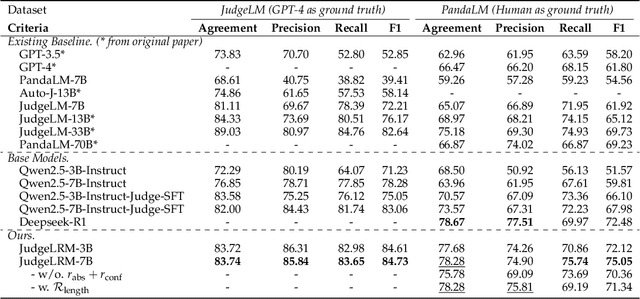
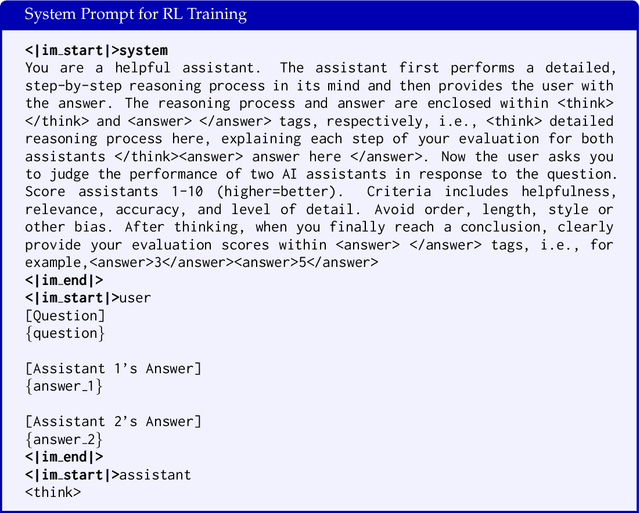
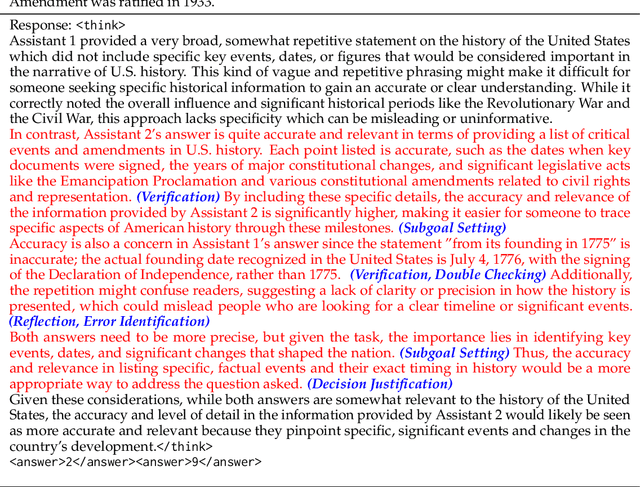
Abstract:The rise of Large Language Models (LLMs) as evaluators offers a scalable alternative to human annotation, yet existing Supervised Fine-Tuning (SFT) for judges approaches often fall short in domains requiring complex reasoning. In this work, we investigate whether LLM judges truly benefit from enhanced reasoning capabilities. Through a detailed analysis of reasoning requirements across evaluation tasks, we reveal a negative correlation between SFT performance gains and the proportion of reasoning-demanding samples - highlighting the limitations of SFT in such scenarios. To address this, we introduce JudgeLRM, a family of judgment-oriented LLMs trained using reinforcement learning (RL) with judge-wise, outcome-driven rewards. JudgeLRM models consistently outperform both SFT-tuned and state-of-the-art reasoning models. Notably, JudgeLRM-3B surpasses GPT-4, and JudgeLRM-7B outperforms DeepSeek-R1 by 2.79% in F1 score, particularly excelling in judge tasks requiring deep reasoning.
 Add to Chrome
Add to Chrome Add to Firefox
Add to Firefox Add to Edge
Add to Edge